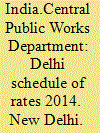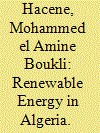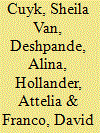|
|
|
Sort Order |
|
|
|
Items / Page
|
|
|
|
|
|
|
| Srl | Item |
| 1 |
ID:
084043


|
|
|
|
|
| Publication |
London, Library Association Publishing, 2002.
|
| Description |
vi, 147p.
|
| Standard Number |
185604422X
|
|
|
|
|
|
|
|
|
|
|
|
Copies: C:1/I:0,R:0,Q:0
Circulation
| Accession# | Call# | Current Location | Status | Policy | Location |
| 045700 | 025.28/LEE 045700 | Main | On Shelf | General | |
|
|
|
|
| 2 |
ID:
140954


|
|
|
|
|
| Publication |
New Delhi, Central Public Works Department, 2014.
|
| Description |
x, 442p.hbk
|
|
|
|
|
|
|
|
|
|
|
|
Copies: C:1/I:0,R:0,Q:0
Circulation
| Accession# | Call# | Current Location | Status | Policy | Location |
| 058317 | 692.5095456/IND 058317 | Main | On Shelf | General | |
|
|
|
|
| 3 |
ID:
168645


|
|
|
|
|
| Summary/Abstract |
The building energy efficiency labeling (BEEL) scheme has been adopted in China since 2008. However, until now, its effect on the actual building energy efficiency has not been accurately established. The objective of this study was to investigate this effect through a case study in Shanghai, China. Additionally, by performing a thorough review, potential barriers for implementing the BEEL scheme in major areas of China were analyzed. The results indicated that 1) the energy use intensity of labeled commercial office buildings in Shanghai followed a normal distribution, with an average value of 79.14 kWh/(m2a); 2) the energy-saving rate and energy consumption exhibited an inversely proportional relationship for residential buildings, but this relationship was not applicable for commercial office buildings; 3) for Shanghai, ground source heat pumps (GSHPs) and variable refrigerant volume systems are more appropriate for commercial office buildings, and GSHPs and split air conditioners are more useful for residential buildings. The potential barriers were classified into three main categories—technical, political, and awareness—and corresponding solutions were proposed. The authors hope that this study can promote the adoption of the BEEL scheme in China.
|
|
|
|
|
|
|
|
|
|
|
|
|
|
|
|
| 4 |
ID:
127519


|
|
|
| 5 |
ID:
175266


|
|
|
|
|
| Summary/Abstract |
In light of the Swiss government's reduction targets for greenhouse gas (GHG) emissions under the Paris Agreement, this article investigates how and with which policy measures these reduction targets can be met for the Swiss residential building sector. The paper applies an agent-based building stock model to simulate the development of the Swiss residential building stock under three different policy scenarios. The scenario results until 2050 are compared against the reduction targets set by the Swiss government and with each other. The results indicate that while the current state of Swiss climate policy is effective in reducing energy demand and GHG emissions, it will not be enough to reach the ambitious emission-reduction targets. These targets can be reached only through an almost complete phase-out of fossil-fuel heating systems by 2050, which can be achieved through the introduction of further financial and/or regulatory measures. The results indicate that while financial measures such as an increase in the CO2 tax as well as subsidies are effective in speeding up the transition in the beginning, a complete phase-out of oil and gas by 2050 is reached only through additional regulatory measures such as a CO2 limit for new and existing buildings.
|
|
|
|
|
|
|
|
|
|
|
|
|
|
|
|
| 6 |
ID:
175102


|
|
|
|
|
| Summary/Abstract |
Algeria, like other developing countries, has been committed to promoting the transition to renewable energy for several years. The national government established several laws and attractive subsidies that encouraged various socio-economic entities to use renewable energies and engage in more sustainable practices. Despite these efforts, industrial and private entities have not responded as hoped. To identify the factors that impede government efforts toward sustainable practices, this paper focuses on the two most energy-consuming sectors: building and transport. The analysis reveals that both financial and socio-cultural issues constitute the two main obstructive elements to energy transition in Algeria. This is the first study to be carried out in Algeria on technico-economic difficulties in the application of energy transition towards renewable sources.
|
|
|
|
|
|
|
|
|
|
|
|
|
|
|
|
| 7 |
ID:
101488


|
|
|
|
|
| Publication |
2010.
|
| Summary/Abstract |
The rapid growth of energy use, worldwide, hfs raised concerns over problems of energy supply and exhaustion of energy resources. Most of the developed countries are implementing building energy regulations such as energy standards, codes etc., to reduce building energy consumption. The position of developing countries with respect to energy regulations implementation and enforcement is either poorly documented or not documented at all. In addition, there is a lack of consistent data, which makes it difficult to understand the underlying changes that affect energy regulation implementation in developing countries. In that respect, this paper investigates the progress of building energy regulations in developing countries and its implication for energy conservation and efficiency. The present status of building energy regulations in 60 developing countries around the world was analysed through a survey of building energy regulations using online survey. The study revealed the present progress made on building energy regulations in relation to implementation, development and compliance; at the same time the study recommends possible solutions to the barriers facing building energy regulation implementation in the developing world.
|
|
|
|
|
|
|
|
|
|
|
|
|
|
|
|
| 8 |
ID:
185925


|
|
|
|
|
| Summary/Abstract |
This paper traces the changes and continuities in the cityscape of Soviet Samarkand following the launch of the mass housing campaign under Nikita Khrushchev. It examines the planning, building, appropriation, and renovation of public and private housing on the level of practices rather than policies and discourses. The paper relates these practices to the specific temporalities of Samarkand’s landscape, such as the life cycles of inhabitants, the change of seasons, or the timelines of material decay, among others. It shows that self-help building often proved to be more effective than state projects in addressing these temporalities. Drawing on site-specific cultural, material, and technical repertoires, self-help building was more than a pragmatic reaction to the housing shortage. It sustained the traditional Central Asian neighbourhood that Soviet planners hoped to banish from the urban landscape and was key to the expansion and diversification, rather than homogenization, of the ‘Soviet’ cityscape.
|
|
|
|
|
|
|
|
|
|
|
|
|
|
|
|
| 9 |
ID:
126258


|
|
|
|
|
| Publication |
2012.
|
| Summary/Abstract |
Understanding the fate and transport of biological agents into buildings will be critical to recovery and restoration efforts after a biological attack in an urban area. As part of the Interagency Biological Restoration Demonstration (IBRD), experiments were conducted in Fairfax County, VA, to study whether a biological agent can be expected to infiltrate into buildings following a wide-area release. Bacillus thuringiensis var. kurstaki is a common organic pesticide that has been sprayed in Fairfax County for a number of years to control the gypsy moth. Because the bacterium shares many physical and biological properties with Bacillus anthracis, the results from these studies can be extrapolated to a bioterrorist release. In 2009, samples were collected from inside buildings located immediately adjacent to a spray block. A combined probabilistic and targeted sampling strategy and modeling were conducted to provide insight into likely methods of infiltration. Both the simulations and the experimental results indicate sampling entryways and heating, ventilation, and air conditioning (HVAC) filters are reasonable methods for "ruling in" a building as contaminated. Following a biological attack, this method is likely to provide significant savings in time and labor compared to more rigorous, statistically based characterization. However, this method should never be used to "rule out," or clear, a building.
|
|
|
|
|
|
|
|
|
|
|
|
|
|
|
|
|
|
|
|
|